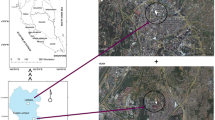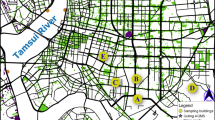Abstract
From 28 November to 23 December 2009, 24-h PM2.5 samples were collected simultaneously at six sites in Guangzhou. Concentrations of 18 polycyclic aromatic hydrocarbons (PAHs) together with certain molecular tracers for vehicular emissions (i.e., hopanes and elemental carbon), coal combustion (i.e., picene), and biomass burning (i.e., levoglucosan) were determined. Positive matrix factorization (PMF) receptor model combined with tracer data was applied to explore the source contributions to PAHs. Three sources were identified by both inspecting the dominant tracer(s) in each factor and comparing source profiles derived from PMF with determined profiles in Guangzhou or in the Pearl River Delta region. The three sources identified were vehicular emissions (VE), biomass burning (BB), and coal combustion (CC), accounting for 11 ± 2 %, 31 ± 4 %, and 58 ± 4 % of the total PAHs, respectively. CC replaced VE to become the most important source of PAHs in Guangzhou, reflecting the effective control of VE in recent years. The three sources had different contributions to PAHs with different ring sizes, with higher BB contributions (75 ± 3 %) to four-ring PAHs such as pyrene and higher CC contributions (57 ± 4 %) to six-ring PAHs such as benzo[ghi]perylene. Temporal variations of VE and CC contributions were probably caused by the change of weather conditions, while temporal variations of BB contributions were additionally influenced by the fluctuation of BB emissions. Source contributions also showed some spatial variations, probably due to the source emission variations near the sampling sites.








Similar content being viewed by others
References
Belis CA, Cancelinha J, Duane M, Forcina V, Pedroni V, Passarella R, Tanet G, Douglas K, Piazzalunga A, Bolzacchini E, Sangiorgi G, Perrone MG, Ferrero L, Fermo P, Larsen BR (2011) Sources for PM air pollution in the Po Plain, Italy: I. Critical comparison of methods for estimating biomass burning contributions to benzo(a)pyrene. Atmos Environ 45(39):7266–7275. doi:10.1016/j.atmosenv.2011.08.061
Bi XH, Sheng GY, Peng P, Chen YJ, Zhang ZQ, Fu JM (2003) Distribution of particulate- and vapor-phase n-alkanes and polycyclic aromatic hydrocarbons in urban atmosphere of Guangzhou, China. Atmos Environ 37(2):289–298
Birch ME, Cary RA (1996) Elemental carbon-based method for monitoring occupational exposures to particulate diesel exhaust. Aerosol Sci Tech 25(3):221–241
Fraser MP, Lakshmanan K (2000) Using levoglucosan as a molecular marker for the long-range transport of biomass combustion aerosols. Environ Sci Technol 34(21):4560–4564. doi:10.1021/Es991229l
Fung F, He H, Sharpe B, Kamakaté F, Blumberg K (2010) Overview of China’s vehicle emission control program. (http://www.theicct.org/node/6)
Gao B, Yu J-Z, Li S-X, Ding X, He Q-F, Wang X-M (2011) Roadside and rooftop measurements of polycyclic aromatic hydrocarbons in PM2.5 in urban Guangzhou: evaluation of vehicular and regional combustion source contributions. Atmos Environ 45(39):7184–7191. doi:10.1016/j.atmosenv.2011.09.005
Gao B, Guo H, Wang XM, Zhao XY, Ling ZH, Zhang Z, Liu TY (2012) Spatiotemporal variations and sources of polycyclic aromatic hydrocarbons in Guangzhou, southern China. J Hazard Mater. doi:10.1016/j.jhazmat.2012.07.068
Guo H, Lee SC, Ho KF, Wang XM, Zou SC (2003) Particle-associated polycyclic aromatic hydrocarbons in urban air of Hong Kong. Atmos Environ 37(38):5307–5317. doi:10.1016/j.atmosenv.2003.09.011
He LY, Hu M, Zhang YH, Huang XF, Yao TT (2008) Fine particle emissions from on-road vehicles in the Zhujiang Tunnel, China. Environ Sci Technol 42(12):4461–4466
Inomata Y, Kajino M, Sato K, Ohara T, Kurokawa J-I, Ueda H, Tang N, Hayakawa K, Ohizumi T, Akimoto H (2012) Emission and atmospheric transport of particulate PAHs in Northeast Asia. Environ Sci Technol 46(9):4941–4949. doi:10.1021/es300391w
Lang C, Tao S, Zhang G, Fu J, Simonich S (2007) Outflow of polycyclic aromatic hydrocarbons from Guangdong, Southern China. Environ Sci Technol 41(24):8370–8375
Lang C, Tao S, Liu W, Zhang Y, Simonich S (2008) Atmospheric transport and outflow of polycyclic aromatic hydrocarbons from China. Environ Sci Technol 42(14):5196–5201. doi:10.1021/es800453n
Larsen RK, Baker JE (2003) Source apportionment of polycyclic aromatic hydrocarbons in the urban atmosphere: a comparison of three methods. Environ Sci Technol 37(9):1873–1881
Lee JY, Kim YP (2007) Source apportionment of the particulate PAHs at Seoul, Korea: impact of long range transport to a megacity. Atmos Chem Phys 7(13):3587–3596
Lee S, Liu W, Wang YH, Russell AG, Edgerton ES (2008) Source apportionment of PM2.5: comparing PMF and CMB results for four ambient monitoriniz sites in the southeastern United States. Atmos Environ 42(18):4126–4137. doi:10.1016/j.atmosenv.2008.01.025
Li J, Zhang G, Li XD, Qi SH, Liu GQ, Peng XZ (2006) Source seasonality of polycyclic aromatic hydrocarbons (PAHs) in a subtropical city, Guangzhou, South China. Sci Total Environ 355(1–3):145–155
Li W, Peng Y, Shi J, Qiu W, Wang J, Bai Z (2011) Particulate polycyclic aromatic hydrocarbons in the urban Northeast Region of China: profiles, distributions and sources. Atmos Environ 45(40):7664–7671. doi:10.1016/j.atmosenv.2011.04.004
Ma W-L, Sun D-Z, Shen W-G, Yang M, Qi H, Liu L-Y, Shen J-M, Li Y-F (2011) Atmospheric concentrations, sources and gas-particle partitioning of PAHs in Beijing after the 29th Olympic Games. Environ Pollut 159(7):1794–1801. doi:10.1016/j.envpol.2011.03.025
NIOSH (1999) Method 5040 Issue 3 (Interim): elemental carbon (diesel exhaust), in: NIOSH manual of analytical methods. National Institute of Occupational Safety and Health, Cincinnati
Okuda T, Naoi D, Tenmoku M, Tanaka S, He K, Ma Y, Yang F, Lei Y, Jia Y, Zhang D (2006) Polycyclic aromatic hydrocarbons (PAHs) in the aerosol in Beijing, China, measured by aminopropylsilane chemically-bonded stationary-phase column chromatography and HPLC/fluorescence detection. Chemosphere 65(3):427–435. doi:10.1016/j.chemosphere.2006.01.064
Okuda T, Okamoto K, Tanaka S, Shen Z, Han Y, Huo Z (2010) Measurement and source identification of polycyclic aromatic hydrocarbons (PAHs) in the aerosol in Xi’an, China, by using automated column chromatography and applying positive matrix factorization (PMF). Sci Total Environ 408(8):1909–1914. doi:10.1016/j.scitotenv.2010.01.040
Oros DR, Simoneit BRT (2000) Identification and emission rates of molecular tracers in coal smoke particulate matter. Fuel 79(5):515–536
Paatero P (1997) Least squares formulation of robust non-negative factor analysis. Chemometr Intell Lab 37(1):23–35
Paatero P, Tapper U (1994) Positive matrix factorization—a nonnegative factor model with optimal utilization of error-estimates of data values. Environmetrics 5(2):111–126
Robinson AL, Subramanian R, Donahue NM, Bernardo-Bricker A, Rogge WF (2006) Source apportionment of molecular markers and organic aerosols-1. Polycyclic aromatic hydrocarbons and methodology for data visualization. Environ Sci Technol 40(24):7803–7810
Schauer JJ, Rogge WF, Hildemann LM, Mazurek MA, Cass GR (1996) Source apportionment of airborne particulate matter using organic compounds as tracers. Atmos Environ 30(22):3837–3855
Sheesley RJ, Andersson A, Gustafsson O (2011) Source characterization of organic aerosols using Monte Carlo source apportionment of PAHs at two South Asian receptor sites. Atmos Environ 45(23):3874–3881. doi:10.1016/j.atmosenv.2011.01.031
Shrivastava MK, Subramanian R, Rogge WF, Robinson AL (2007) Sources of organic aerosol: positive matrix factorization of molecular marker data and comparison of results from different source apportionment models. Atmos Environ 41(40):9353–9369. doi:10.1016/j.atmosenv.2007.09.016
Simoneit BRT (2002) Biomass burning—a review of organic tracers for smoke from incomplete combustion. Appl Geochem 17(3):129–162
Tian F, Chen J, Qiao X, Wang Z, Yang P, Wang D, Ge L (2009) Sources and seasonal variation of atmospheric polycyclic aromatic hydrocarbons in Dalian, China: factor analysis with non-negative constraints combined with local source fingerprints. Atmos Environ 43(17):2747–2753. doi:10.1016/j.atmosenv.2009.02.037
van Drooge BL, Ballesta PP (2009) Seasonal and daily source apportionment of polycyclic aromatic hydrocarbon concentrations in PM10 in a semirural European area. Environ Sci Technol 43(19):7310–7316
Vestenius M, Leppanen S, Anttila P, Kyllonen K, Hatakka J, Hellen H, Hyvarinen AP, Hakola H (2011) Background concentrations and source apportionment of polycyclic aromatic hydrocarbons in south-eastern Finland. Atmos Environ 45(20):3391–3399. doi:10.1016/j.atmosenv.2011.03.050
Xu SS, Liu WX, Tao S (2006) Emission of polycyclic aromatic hydrocarbons in China. Environ Sci Technol 40(3):702–708
Yang Y, Guo P, Zhang Q, Li D, Zhao L, Mu D (2010) Seasonal variation, sources and gas/particle partitioning of polycyclic aromatic hydrocarbons in Guangzhou, China. Sci Total Environ 408(12):2492–2500. doi:10.1016/j.scitotenv.2010.02.043
Zhang YX, Schauer JJ, Zhang YH, Zeng LM, Wei YJ, Liu Y, Shao M (2008) Characteristics of particulate carbon emissions from real-world Chinese coal combustion. Environ Sci Technol 42(14):5068–5073
Zhang YX, Sheesley RJ, Bae MS, Schauer JJ (2009a) Sensitivity of a molecular marker based positive matrix factorization model to the number of receptor observations. Atmos Environ 43(32):4951–4958. doi:10.1016/j.atmosenv.2009.07.009
Zhang YX, Sheesley RJ, Schauer JJ, Lewandowski M, Jaoui M, Offenberg JH, Kleindienst TE, Edney EO (2009b) Source apportionment of primary and secondary organic aerosols using positive matrix factorization (PMF) of molecular markers. Atmos Environ 43(34):5567–5574. doi:10.1016/j.atmosenv.2009.02.047
Acknowledgments
This study was supported by the National Natural Science Foundation of China (Project No. 40821003/41025012), the Research Grants Council of the Hong Kong Special Administrative Region (Project No. PolyU 5179/09E), and the Joint Scheme of National Natural Science Foundation of China and Research Grants Council of Hong Kong (NSFC/RGC joint project No. N_PolyU545/09). This project was partially supported by the Hong Kong Polytechnic University Internal Fund (project No. A-PL40).
Author information
Authors and Affiliations
Corresponding authors
Additional information
Responsible editor: Gerhard Lammel
Rights and permissions
About this article
Cite this article
Gao, B., Guo, H., Wang, XM. et al. Tracer-based source apportionment of polycyclic aromatic hydrocarbons in PM2.5 in Guangzhou, southern China, using positive matrix factorization (PMF). Environ Sci Pollut Res 20, 2398–2409 (2013). https://doi.org/10.1007/s11356-012-1129-0
Received:
Accepted:
Published:
Issue Date:
DOI: https://doi.org/10.1007/s11356-012-1129-0




